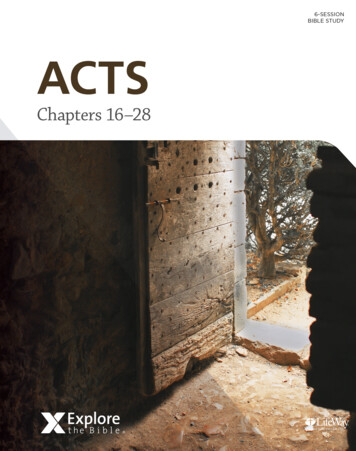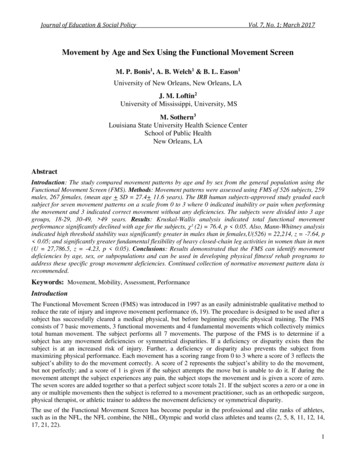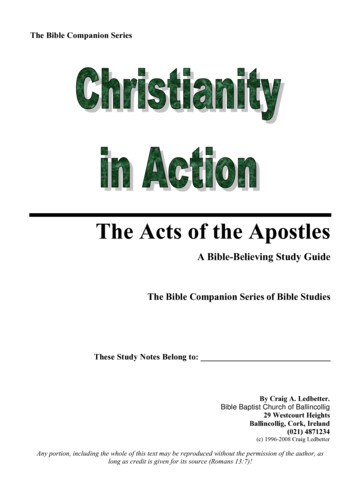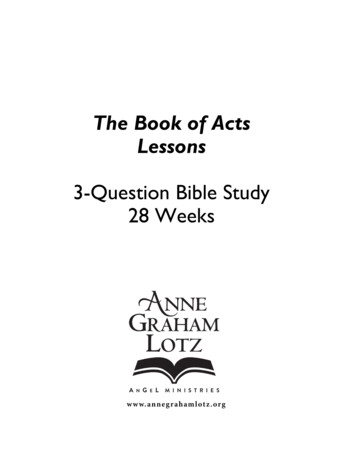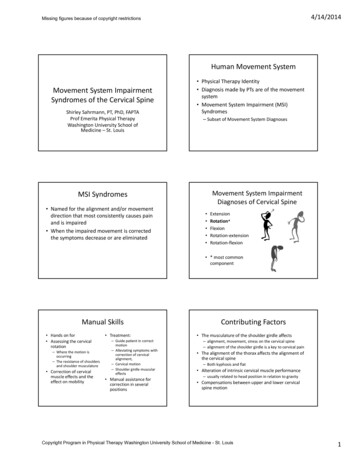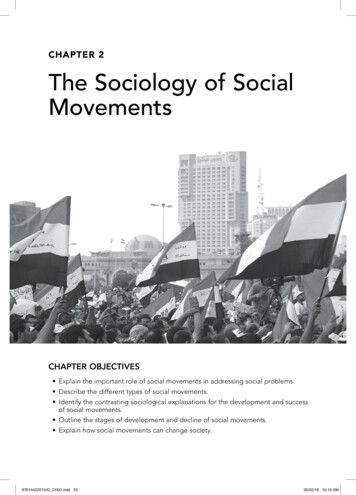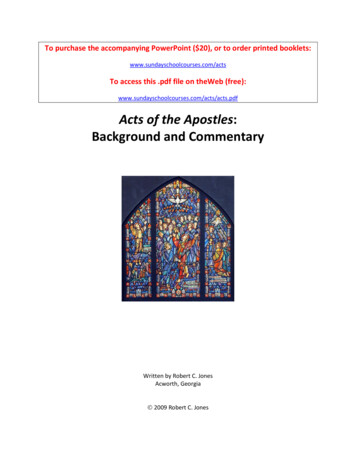
Transcription
Acts to ActionThe New Testament’s Guide toEvangelism and MissionEdited bySusan Brown SnookAdam TrambleyContributorsJoseph Alsay, Carrie Boren Headington,Frank Logue, Brendan O’Sullivan-Hale,Steve Pankey, and Holli PowellWithJennifer Baskerville-BurrowsForeWordGay Clark JenningsAfterwordForward MovementCincinnati, Ohio
Table of ContentsForeword . VIIIntroduction. XISection One: Acts 8:1-4. 1The Story. 3Chapter 1: Signs of the Times. 7Chapter 2: Worship .19Section Two: Acts 8:5-8. 29The Story.31Chapter 3: Proclamation . 33Chapter 4: Loving and Serving . 43Section Three: Acts 8:9-25. 53The Story. 55Chapter 5: Repentance . 59Chapter 6: Prayer .71v
Acts to ActionSection Four: Acts 8:26-40.81The Story. 83Chapter 7: Scripture . 87Chapter 8: Knowing the Community . 97Conclusion: Evangelism in Relationship. 109Afterword. 117About the Editors.121About the Contributors.123About Forward Movement.127vi
IntroductionSusan Brown SnookIt is a difficult time for the church. Social forces haveimpacted believers in such a way that it’s not clear howthe community of faith can continue. The institutionsthat have held the church together are breaking apart,and people have scattered, unsure of their next step,uncertain whether the gospel will survive into the nextgeneration.The Christian church in the twenty-first century? No.This is the scenario facing the followers of the Way inJerusalem, 40 ce. These early followers of Jesus encounterseemingly insurmountable obstacles: persecution,uncertainty, doubt, and fear. Yet empowered by the HolySpirit, the handful of early followers share the good newsof Jesus Christ far and wide. These few faithful followersstart a worldwide movement, one of hope and joy andthe promise of abundant life.The description of those early days in the church mightsound familiar to us. The Episcopal Church and indeedmost mainline denominations in North America facesome grim realities: Attendance is declining, sometimesprecipitously, our membership is aging, and many of ourfinancial resources are drying up. The population of NorthAmerica is growing rapidly while many of our churchesxi
Acts to Actionare shrinking, demographically looking less and less likethe surrounding neighborhoods. We flounder, not surehow to reach the people God loves so dearly. Yet thereis great hope and possibility. We believe that the gospel,the good news of Christ, is a vital message for all to hear.God’s love for us is so intense that it led Jesus Christ, theSon of God, to come into this world and live and die forus; it is a love so unconquerable that God raised Jesusfrom the dead; a love so eternal that God sent the HolySpirit to us so that God’s love would grow and spreadthroughout the world. This love is worth sharing withthose around us. But how do we accomplish this missionwhen our church structures seem to be faltering, whenwe are unsure of a way forward, when we don’t alwaysunderstand the good news of God in Christ ourselves?We can look for answers through the spiritual disciplinesall Christians are called to: prayer, scripture reading,worship, giving, serving others, and discernment of ourmission in community. We can also look to the 2,000-yearstory of the church to see how God has led Christianson this path before. And when we do, we find that thefollowers of the Way have confronted similar challengesfrom the very beginning. We find their story—and ourstory—in the New Testament Book of Acts.As Acts opens, the resurrected Jesus speaks his lastwords to his friends before he ascends into heaven. Thesewords in Acts 1:8 are in a sense the mission statementfor the entire Book of Acts, a foreshadowing of howthe story of the church will unfold. Jesus says, “But youwill receive power when the Holy Spirit has come uponyou; and you will be my witnesses in Jerusalem, in allxii
INTRODUCTIONJudea and Samaria, and to the ends of the earth.” Thismission statement draws a picture of concentric circles:Jerusalem at the center, the familiar country of Judeasurrounding it, the unfamiliar enemy territory of Samariabeyond that, and the unknown wilds of the ends of theearth extending to the entire known world and beyond.This is an overwhelming mission, but Jesus doesn’t thinksmall. The Holy Spirit comes with power, and the gospelis going to spread.The apostles create an organization in Jerusalem, onewith assigned roles and delegation of responsibilities todeacons and others. This method of organization hasbeen highly successful, baptizing thousands of peoplewho are inspired by the story of Jesus. By the power ofthe Holy Spirit, the apostles preach in the temple andgather large crowds of believers. The whole structure isgrowing, reaching new people and seeming to portenda great revival in religious life in Jerusalem. Then, justbefore Acts Chapter 8, the crisis comes. Stephen speaksout of turn, insisting that the older temple organizationis not necessary. Stephen is killed for his words, and apersecution begins. The fledgling institution is destroyedand scattered, and no one knows what to do next.No one, that is, except the Holy Spirit. Where humanplans fail, God is doing something new. It turns outthe very persecution that scatters the believers anddestroys their institutions becomes the seed of new lifein unexpected places and ways. The twelve apostleshave assumed that the main life of the church will alwayscontinue in Jerusalem, headquartered in the temple.But the Holy Spirit flings the church out into new andXIIi
Acts to Actionfrightening places: Samaria and the road to Gaza anda place called Azotus. The Ethiopian eunuch becomesa Christian and heads back home, carrying the gospelwith him to a place the apostles would surely think of as“the ends of the earth.” Baptism happens in a puddle ofwater alongside a road, instead of in a carefully plannedliturgical ceremony.Sharing the gospel of Christ rarely happens in a smooth,graceful progression. The apostles have successes andsetbacks. They work wondrous miracles and make rookiemistakes. They struggle with each other over differentinterpretations of their mission, and they struggle tofollow the lead of the Spirit in fits and starts. They fail totake literally the mandate from Jesus to go to “the endsof the earth,” and they stay in Jerusalem where they arecomfortable—until they just can’t stay there anymore.These early followers face the same challenges thatwe do today. Like the first apostles, we know how tobe the church in the familiar surroundings of our owntemples, our own “Jerusalems.” What we’re not sure ofis how to be the church outside our walls, even in thefamiliar “Judeas” of our neighborhoods and amongpeople similiar to us. We’re even less sure of how tointeract with our unfamiliar neighbors, the “Samaritans”who might be of different races or social classes orpolitical outlooks or life experiences or religious (or nonreligious) backgrounds. Yet, we are called to reach them.We must reach them if our churches are to thrive, but wedon’t know how. We are indeed in the midst of beingscattered, flung headlong into a new world.Xiv
INTRODUCTIONActs Chapter 8, the story of how the first disciples respondto challenges similar to ours, provides rich and fertileground for us to discover how to meet today’s crises.This book studies the events of Acts 8 and exploreshow we might apply its lessons to the life and missionof our churches today. Many of the contributors to thisbook are members of the Acts 8 Movement, a groupof Episcopalians dedicated to mission, evangelism,and discerning the call of the Holy Spirit in our churchtoday. The Acts 8 Movement was established before theEpiscopal Church’s 2012 General Convention by ScottGunn, Tom Ferguson, and me to be an advocate forchange in the church.1 Since 2012, Acts 8 has continuedto grow and evolve as a loosely organized yet passionategroup of advocates for evangelism and prayer in theEpiscopal Church.Out of our zeal for sharing the good news of Christ,we offer this book, which explores the lessons of ActsChapter 8 and offers them as a model for church missiontoday. We hope the book is used by individuals and ingroup study; discussion questions and practical exercisescan help individuals and congregations discover howto answer their calling from the Holy Spirit. The book isdivided into four sections, based on the four fascinatingstories we find in Acts Chapter 8. At the beginning of eachsection, we explore in greater depth the scriptural story.Then building upon these stories, we look at essentialelements of church mission in the twenty-first century.Read the original blog posts announcing this new g-posts/.1XV
Acts to ActionThe first section looks at the change that comes to thechurch as a result of the persecution of Stephen and howthis change brings new focus to the proclamation of thegospel. Then we explore Philip’s trip to Samaria and howhis proclamation opposes evil and brings joy. The thirdsection concentrates on the curious story of Simon theMagus, with lessons about the changes that come to usin repentance and the power of prayer. In the last section,we hear the beautiful story of Philip and the Ethiopianeunuch, which reminds us of how to read scripture andhow to work to understand our own communities.Ultimately, these stories in Acts Chapter 8 share acommon thread of relational evangelism and beg thequestion: How do we share the good news of Christthat we have experienced with the people we meet inthe course of our ordinary lives? Every congregationmust confront this vital question as we consider how toaccomplish the mission that Jesus still gives us: to behis witnesses in our churches and in our neighborhoods,among people we know and trust, among people whoare different and strange to us, and ultimately, to theends of the earth.XVI
Section OneActs 8:1-4And Saul approved of their killing him. That day a severepersecution began against the church in Jerusalem, andall except the apostles were scattered throughout thecountryside of Judea and Samaria. Devout men buriedStephen and made loud lamentation over him. But Saulwas ravaging the church by entering house after house;dragging off both men and women, he committed themto prison. Now those who were scattered went fromplace to place, proclaiming the word.
The StoryBrendan O’Sullivan-HaleHolli PowellThe eighth chapter in the Acts of the Apostles couldbe summed up in a phrase from Lin-Manuel Miranda’smusical Hamilton: “This is not a moment; it’s themovement.” At the beginning of the chapter, those whohave placed their hope in a light shining in the darknessare themselves on the verge of being snuffed out. By theend of the chapter, the faith has escaped the confinesof Jerusalem, carried out into cities and the wildernessalike by Christians with hearts enflamed by the Spirit.The Book of Acts was written by Luke as the secondvolume of a series. The first volume, the familiar andbeloved Gospel of Luke, tells the story of Jesus’ life, frombirth to resurrection. The second volume, the Acts of theApostles, picks up where the Gospel of Luke leaves off,with the resurrected Jesus about to ascend into heaven.From this point, the followers of Jesus have to learn howto be the church and carry on Christ’s mission withouthis physical presence. They start out in Jerusalem andorganize a successful missional community there. But atthe end of Chapter 7, Stephen is stoned to death, and atthe beginning of Chapter 8, a persecution against thechurch in Jerusalem scatters the followers of Jesus intothe countryside.3
Acts to ActionThe first few verses of Acts Chapter 8 are a geographicpivot as definitive as the change in direction towardJerusalem in Luke’s account of the Transfiguration. Afterteaching his disciples that “those who want to save theirlife will lose it, and those who lose their life for my sakewill save it” (Luke 9:24), Jesus ascends a nearby mountainto show Peter, James, and John his divine authority inthe event we know as the Transfiguration. From thatmoment on, each step Jesus and his disciples take is inthe direction of Jerusalem and toward the cross.The death of Stephen recalls the Transfiguration, onlythe geographic direction is reversed. Testifying beforethe high priest, Stephen’s face “was like the face of anangel” (Acts 6:15). In the moment before the assembledcrowd seizes him, “he sees the heavens opened” (Acts7:56). Finally, turning his spirit over to Christ as stonesrain down on him, Stephen cries out for the forgivenessof his murderers, showing himself transformed throughthe imitation of his Lord.From the moment of Stephen’s transfiguration, the stepsof Christ’s followers move away from Jerusalem andout into the wider world, as most of the Christians fleeSaul’s persecution. Human nature would lead many ofus to flee Saul’s rampage against Christians and startover elsewhere, quietly, not making a fuss or causinga commotion in our new town. But these Christians gofrom place to place, boldly telling the story of their faithto everyone who will listen. Saul’s attempt at shuttingdown the practicing believers backfires spectacularly,as his tactics inadvertently encourage the spread ofChristianity beyond Jerusalem.4
Act s 8:1-4But not everyone leaves Jerusalem. The apostles staybehind for reasons that are unknown to us. Immediatelybefore the Ascension, Jesus instructs them “not to leaveJerusalem, but to wait there for the promise of the Father”(Acts 1:4). Still, they are clearly aware that the gospelpromise is to go well beyond Jerusalem. Pentecost bringsthe gift of the Holy Spirit to the apostles, but some of thecrowd sneers and assumes they are drunk. Peter urgesthe crowds to repent and be baptized, assuring themthat the promise of forgiveness and the gift of the HolySpirit is “for you, for your children, and for all who are faraway” (Acts 2:39).For whatever reason, a new set of believers who havenever personally met Jesus are the ones to carry themessage out of Jerusalem and into the world. Perhaps,having been companions of Jesus, the apostles lackthe imagination and vision for how to build the churchwithout his physical presence and guidance. WhenThomas doubts the resurrection without physical proof,Jesus answers: “Blessed are those who have not seen andyet come to believe” (John 20:29). These early Christiansspread their faith with no proof of the resurrection otherthan their own transformed lives. Why do those whohave never known Jesus in person carry the church’smission forward? Maybe they are the only ones who canimagine the way forward being passed from person toperson, sparked by the Holy Spirit. Their way focusesnot on direct experience of the physical incarnation ofChrist but on his message: the gospel and its power totransform us all.5
story—in the New Testament Book of Acts. As Acts opens, the resurrected Jesus speaks his last words to his friends before he ascends into heaven. These words in Acts 1:8 are in a sense the mission statement for the entire Book of Acts, a foreshadowing of how the story of the church will unfold. Jesus says, "But you

